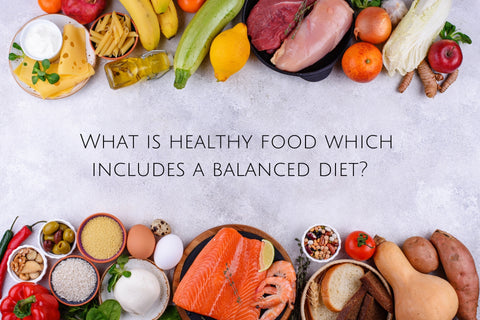However, embracing a balanced diet doesn't have to be complicated or daunting. By understanding the principles of healthy eating and incorporating nutrient-rich foods into your daily routine, you can embark on a journey toward a healthier and more fulfilling life.
What is Healthy Food?
Healthy food is food that provides your body with the nutrients it needs to function properly. It includes a variety of foods from all food groups, including fruits, vegetables, whole grains, lean protein, and low-fat dairy. Embracing a balanced diet can promote overall well-being and reduce the risk of health issues.
What is a Balanced Diet?
A balanced diet is a diet that provides your body with all the nutrients it needs in the right amounts. It includes a variety of foods from all food groups, and it is low in saturated and trans fats, sodium, and added sugar. A balanced diet can help you maintain a healthy weight, reduce your risk of chronic diseases, and improve your overall health.
The Pillars of a Balanced Diet
A balanced diet is not about deprivation or strict adherence to rigid rules. Instead, it's about nourishing your body with a variety of nutrient-rich foods that support your overall health and well-being. A balanced diet is a symphony of nutrients that our bodies crave to function optimally. It's not just about counting calories; it's about embracing variety and choosing nutrient-dense foods. The key to achieving a balanced diet lies in understanding the five food groups:
Fruits:
Fruits are nature's candy, packed with essential vitamins, minerals, and fiber. Aim to consume at least two servings of fruits per day. Rich in vitamins, minerals, antioxidants, and fiber, these colorful gems are essential for a robust immune system, healthy digestion, and overall vitality. Aim for a rainbow on your plate to get a diverse range of nutrients.
Vegetables:
Vegetables are the unsung heroes of a healthy diet, providing a wealth of nutrients and fiber. Aim for at least three servings of vegetables each day.
Whole Grains:
Whole grains are the foundation of a balanced diet, offering fiber, vitamins, and complex carbohydrates. Opt for whole-wheat bread, brown rice, and quinoa over refined grains. They are packed with fiber, B vitamins, and minerals, offering sustained energy and promoting gut health.
Lean Protein:
Protein is essential for building and repairing tissues, and it also helps you feel full and satisfied. Incorporate lean protein sources such as poultry, fish, tofu, beans, and legumes into your meals. These provide amino acids for muscle repair, aid in weight management, and keep you feeling full longer.
Healthy Fats:
While fats have long been demonized, healthy fats play a crucial role in hormone production, nutrient absorption, and brain function. Integrating nutrient-rich fats from avocados, nuts, seeds, and olive oil into your daily meals empowers you to fuel your body with essential nourishment and flavorful goodness. These fats support brain function, help absorb certain vitamins, and contribute to heart health.
Creating a Balanced Plate
By incorporating foods from all five food groups into your meals, you're creating a balanced plate that provides your body with the nutrients it needs to thrive. Here's a simple approach to building a balanced meal:
Fill half your plate with fruits and vegetables:
This ensures you're getting a generous dose of vitamins, minerals, and fiber.
Choose a quarter of your plate for whole grains:
Whole grains provide complex carbohydrates, fiber, and essential nutrients.
Dedicate the remaining quarter of your plate to lean protein:
Protein helps you feel full, supports muscle growth, and provides essential amino acids.
Include a drizzle of healthy fats:
Healthy fats enhance nutrient absorption, promote satiety, and contribute to overall health.
Let me provide you with a few instances of nourishing meals and snacks that can invigorate your day:
Breakfast: Oatmeal with berries and nuts, or a whole-wheat bagel with peanut butter and banana.
Lunch: Salad with grilled chicken or fish, or a whole-wheat wrap with vegetables and hummus.
Dinner: Grilled salmon with roasted vegetables, or a lentil soup.
Snacks: Fruits, vegetables, nuts, seeds, or yogurt.
Balancing Indulgence and Healthy Choices
A balanced diet doesn't mean eliminating your favorite treats entirely. It's about finding moderation and making informed choices. If you crave a slice of pizza or a scoop of ice cream, enjoy it in moderation. Remember, a healthy diet is about long-term habits, not short-term deprivation.
The Importance of Adaptability
No single diet fits everyone. Our nutritional needs vary based on age, activity level, and individual health conditions. Consult with a healthcare professional or a registered dietitian to tailor a diet that suits your specific requirements.
Conclusion
A balanced diet is an investment in your overall health and well-being. By understanding the principles of healthy eating and incorporating nutrient-rich foods into your daily routine, you're not just nourishing your body; you're also investing in your energy levels, mood, and overall quality of life. Embrace the journey towards a healthier you, one delicious and nutritious bite at a time.




Comments (0)
There are no comments for this article. Be the first one to leave a message!